| Stargate | |
|---|---|

| |
| Production information | |
| Manufacturer | |
| Designer |
Amelius |
| Technical specifications | |
| Function |
Interplanetary transportation |
| Control system |
Dial Home Device (standard), Dialing computer, Auto-dialer (non-standard) |
| Size |
6.7 meter diameter |
| Made of |
Naquadah |
| Weight |
+29 tons (64,000 lbs) |
| Power source |
Various (ranging from |
| Usage | |
| Affiliation |
Originally Ancients; today, virtually all known races and civilizations |
- " That is how we're supposed to travel light years across the galaxy to other planets."
- —Cameron Mitchell, on the usefulness of stargates
The stargates, also known as Astria Porta in Ancient and the Chappa'ai in Goa'uld, are devices designed by the Ancients that can create artificial wormholes between distant worlds. The "Stargate Network" is often considered to be the Ancients' greatest creation, and as such, they are often referred to as the "Gate-Builders." Alongside their inventing species, the Nox, Asurans, Tollan (with limited assistance from the Nox), and Ori are the only known races that have demonstrated an ability to construct stargates on their own.
The original stargate design was devised by an Alteran called Amelius, from an idea he formulated the night prior to the Alteran exodus from their home galaxy for the Milky Way. It is unknown if he actually built the first of the devices, but they are, nevertheless, among the oldest examples of Ancient technology found in the universe; the gate discovered in Antarctica on Earth has been estimated to be well over 50 million years old.
Names[]

The Milky Way-type stargate on Earth
- "If that's what you want to call, Ring of the Gods is good."
- —Jack O'Neill
The Ancients placed stargates on thousands of worlds across several galaxies, but the gate network was open to use by all, and continues to be a convenient form of travel for many races. Some races, such as the Goa'uld, grew their ways of life around the gates, which became integral to the functioning of their culture.
In turn, most races developed their own names for the stargates. The Ancients called them "Astria Porta". The English word "stargate" is a calque of the Goa'uld word "Chappa'ai", courtesy of a direct translation by Daniel Jackson [citation needed], and "Chappa'ai" is itself a calque of "Astria Porta". The Wraith refer to them simply as "portals."
Although stargates are present on many planets, the vast majority of the races that inhabit them are relatively primitive, and view the gates as no more than divine, sacred or terrifying relics, as evidenced by such names as "Ring of the Gods" and "Circle of Darkness". [citation needed] The K'Tau call their stargate "the annulus". In the Pegasus Galaxy, villagers know them as Rings of the Ancestors and variations thereof. They are also commonly referred to as as simply "the ring" or "the gate."
Technical specifications[]
- "Kind of a ring thing, comes with a dialer, you hit the symbols, it spins around and lights come on, it kind of flushes sideways..."
- —Jack O'Neill
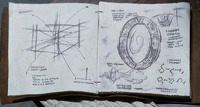
Amelius' Stargate plans.
The stargate is essentially an enormous superconductor, capable of harnessing power from a wide variety of energy sources, especially electricity. When entering through the event horizon, the matter passing through is converted to energy, and then rematerialized at the event horizon of a stargate. Wormholes are one way only, though it is unknown what happens if someone goes through an incoming wormhole (It is equally unknown what would happen if someone entered the stargate via the 'back' rather than the 'front'; in the novel "Stargate SG-1: Survival of the Fittest", Teal'c stated that he knew someone who attempted that on one occasion, and that his death was "most unpleasant", but further details are unknown). The inner track is a safety feature. When the gate has absorbed enough energy this track will unlock, allowing a manual dial in case something bad has happened to the D.H.D. [citation needed] [citation needed]
The stargate has symbols (39 for the Milky Way, 36 for the Pegasus galaxy and others visited by Destiny) which are combined to form a seven-symbol address. Six of the symbols, representing constellations, indicate the destination's three-dimensional coordinates in space, while the seventh indicates the point of origin. For stargates accessing a destination outside of its galaxy, a seventh constellation symbol is necessary, bringing the total to eight. There are 9 chevrons around the device, allowing up to 9 symbols to be dialed. The ninth chevron was revealed to connect to a specific stargate , as oppose to the normal method of connecting to a specific area and the gate inside it. One such example of this is the gate on the Ancient ship Destiny. The stargates on a planet link it to the so called stargate network. How far it spans is unknown, but it is known to link the Alteran Home Galaxy, the Milky Way, Pegasus, and the Ida galaxy, and most likely many others. [citation needed] [citation needed] [citation needed] [citation needed]
Generally, the stargates have dialing devices (DHDs, an acronym for Dial Home Device) placed in front of them by the Ancients or Goa'uld that can be used similarly to a telephone dial to select the place where the connection should go. The stargate found on Earth in the initial movie was missing its dialing device. It was later discovered (in Stargate SG-1) that Russia was in possession of the missing DHD. The Russians acquired the DHD during the Second World War, when they invaded Germany. Somehow, Germany found the DHD originally. [citation needed]

An orbital stargate in the Pegasus Galaxy
Opening the stargate requires an amount of energy much larger than what is required to keep the wormhole open, resulting in an unstable vortex emerging at the "front" of the device. This energy blast will disintegrate anything in its way; however, the vortex can only form if there is a large enough space (several microns) in front of the event horizon. Devices like the iris prevent the vortex from forming. [citation needed]. The vortex creates a pressure wave that is able to move small objects such as hanging lamps. This can be seen at the Kelownan Stargte just before the Tau'ri arrive at Kelowna. [citation needed]
Stargates stay open for a limited period of time; a DHD will force a wormhole to close once the object has reached the other side of the wormhole and no new object has entered, but they are supposed to "time out" at about 38 minutes because a DHD cannot provide enough power to sustain one for longer. There have been rare circumstances where a wormhole has remained active longer, but it requires immense power such as a ZPM or black hole. If there is enough power the gate will automatically remain open if something is still passing through the event horizon. Because it is composed of Naquadah, the stargate is incredibly durable; some have survived ship impacts, black holes, and even meteor impacts. [citation needed]
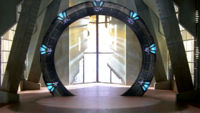
The Atlantis gate in the Pegasus galaxy network, inactive.
In the Pegasus Galaxy, some stargates have been placed in space in orbit above planets, rather than on their surfaces. Because there is no connected DHD, "Spacegates" are powered by three power nodes that also serve as stabilizers, and dialing is accessed by a panel on a spaceship. Puddle jumpers and Wraith Darts are both equipped with such DHDs, and are among the few ships capable of going through the stargate. In the Milky Way galaxy, the Goa'uld once used a special glider to fit through the stargate, but this tactic was abandoned a century ago. [citation needed] [citation needed]
The Ori are known to use the stargates, as this was the way they originally sent Priors from their galaxy to the Milky Way. This means that they are compatible with the Milky Way stargates, but all other details about them at this point are unknown. These gates were most likely built by the Alterans [citation needed]
The Eighth Chevron's purpose was originally unknown until Colonel Jack O'Neill had the information capabilities of the Ancient's stored within his mind through their Repository of knowledge. Using the Power Booster Device he created, along with modifications he made to the SGC's dialing computer, the Eighth Chevron's purpose was revealed. It added an extra distance calculation to the gate allowing it to travel to other galaxies. [citation needed] Since the stargate possesses 39 glyphs, the gate network can theoretically access 38 galaxies (disregarding the origin symbol).
The ninth chevron's purpose was also unknown until a reference to it was found in the Ancient database. It works as a code to identify and dial specific stargates. The only one known address so far is to the gate on Destiny. Dialling it required an enormous amount of power that was supplied through a mechanism which used energy from the core of a planet. The point of origin was Earth even though the aforementioned mechanism wasn't located there. The power core was destabilized when the Lucian Alliance attacked resulting in the destruction of the planet. [citation needed]
Destiny's Gate[]

A Destiny-style Stargate.
The Stargate on the Destiny, and those constructed by stargate seeding ships, is yet another design of the gates. It is also suspected to be the first, "prototype" version of the gates[1]. It was not known how to activate the ninth chevron until Eli Wallace discovered that it requires a code instead of a coordinate to locate different stargates and other gate systems. When activating the eighth chevron, it requires a lot of power to dial, usually supplied by a Zero Point Module.
In the Destiny Gate design, the individual glyphs are separated as opposed to the designs for Pegasus and the Milky Way where they are on an inner ring. They appear not to represent any constellations like Pegasus and Milky Way gates do. The chevrons also appear to be of a slightly different design to what has appeared previously. The triangular part of the chevrons appear to be smaller and more angular at the ends, and the three lines on either side of the triangle are more distinct as individual lights. When dialed, the entire gate spins[2], unlike the Milky Way stargate where only the center ring spins. The gate rotates clockwise until the first address glyph is directly below an orb-shaped bearing indicator which hangs above the gate and functions like the chevrons on other gates: It lights up briefly as each symbol locks directly under it. After the previous glyph is locked, the gate changes direction, spinning counter-clockwise until the next glyph is locked. This alternating process continues until the point-of-origin (7th, 8th or 9th) glyph locks, at which point the Gate bearing remains lit and a final chevron in the floor lights as well. As the gate disengages, all lights turn off at the same time and after a brief moment, vents on either side of the gate release a 2-3 second blast of CO2. [citation needed]
Complexities of function[]
Matter transmission[]

A wormhole produced by a Milky Way stargate
- "We're going to be demolecularized, transmitted over two thousand light years through subspace, and then, uh, rematerialized on the other side."
- —Samantha Carter
When an object passes through the event horizon, it is not immediately transferred to the destination stargate, but rather the portion that has passed through is dematerialized and held in a "hyperspatial buffer". An object that has not completely passed through the event horizon may be pulled out again, and its atoms will be rematerialized from the buffer as it is extracted. [citation needed] The gate does not begin transmitting an object until it has entirely passed through the event horizon. This ensures that only complete objects are transferred. Objects in the buffer remain in a state of suspension. This has been used to "store" people in medical need, but this is a dangerous maneuver, since any disintegrated matter in the buffer "ceases to exist" if the wormhole shuts down before the signal is transmitted. [citation needed] Furthermore, each time the gate is activated the buffer is wiped clean to receive new information. If the control crystal of a connected DHD is removed then an event horizon will form without establishing a wormhole, allowing any memory stored in the stargate to be reintegrated. [citation needed]
Several facets of the stargate are necessary for it to function as a useful personnel transporter. Matter emerging from a stargate retains any kinetic energy it had while entering, so a person running into one stargate will hit the ground running upon emerging from another. (Weapon projectiles also maintain their trajectory and momentum upon transit: a bullet fired through a stargate is just as dangerous as it would be otherwise.) Also, the transmitting gate does not allow the air molecules of the local atmosphere to pass through: the portal differentiates between objects attempting to pass through the event horizon and things that would naturally exert pressure, such as water, air, lava, etc. [citation needed] In one case, the constant pressure of water from a broken ice dam applying pressure to the event horizon and to Atlantis's iris shield kept the wormhole active for the maximum amount of time. [citation needed]
Interestingly, it has been found that a Pegasus galaxy stargate will 'override' a Milky Way gate due to their more advanced design. This was first seen aboard the Midway Space Station and required a special macro to be written allowing both gates to be dialed. A second instance when this effect has been observed was when the Wraith known as 'Kenny' brought a Pegasus gate aboard his ZPM-Powered Hive Ship which overrode the native Earth gate and prevented the Tau'ri from escaping to the Alpha Site. Furthermore, to dial this gate, Dr. Rodney McKay was required to modify the Pegasus DHD to allow it to dial Milky Way co-ordinates, though it was a simple job and took only minutes.
Gate obstruction[]
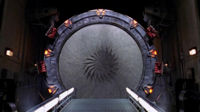
The Iris on Earth's Stargate
- "We have in place an impenetrable shield called an Iris."
- —George S. Hammond
A wormhole is prevented from forming if a significant obstruction is present inside the Stargate's ring. Consequently, it is fairly common for Stargates to be semi- or permanently sealed by burying them.
Another means of controlling travel through a Stargate is by placing a barrier a minuscule distance (less than three micrometers) from the event horizon, which allows the wormhole to form but prevents the reconstitution of matter upon arrival through the gate. In other words, a connection can be made but any matter trying to exit the gate will not regain its original structure, and hence will be annihilated. The iris on the Earth Stargate and the shield on the Atlantis Stargate perform this function, and have been seen to be used as an effective defensive precaution, while still allowing radio communication through the open wormhole. The Goa'uld have also been seen to utilize shields to create much the same effect.
Iris-type barriers also suppress the formation of an unstable vortex by not allowing the matter to form. Such barriers, however, are not the only way to prevent the vortex. Several races, including the Asgard and the Nox, have demonstrated the ability to open a wormhole without the vortex forming, presumably through a more efficient form of energy transmission. [citation needed]
Power source[]
- "The Stargate just got a huge power boost. It's drawing ten times more power than normal."
- —Samantha Carter
Power is always required to establish an outgoing wormhole, and is usually supplied by the DHD, but any Stargate can receive a wormhole whether it has a power supply or not; the dialing gate is the one that supplies power to both. In a few cases, Stargates have been dialed "manually" when more sophisticated means were not available. This was accomplished by providing sufficient raw power to the gate and then rotating the symbol ring by hand to lock each chevron. [citation needed] Power can be fed directly into the naqahdah that comprises the gate; power harnessed from lightning strikes has been shown to be sufficient. [citation needed] The Stargate that establishes an outgoing wormhole determines how long the wormhole is held open, and can generally close the wormhole "at will". Under some conditions, a gate only needs enough power to connect briefly, then the receiving gate can provide enough power to maintain the connection. [citation needed] The same is true if the outgoing gate loses power while transmitting; if the incoming gate has a DHD, it will take over powering the gate until reintegration is complete.
Secondary Stargates[]

The Beta Gate, Earth's secondary Stargate
Some planets are known to possess "secondary" or "backup" Stargates. [citation needed] The second Stargate is normally inactive, with the primary Stargate (defined by the presence of a functioning Dial-Home Device) receiving all incoming wormholes. [citation needed] If a Stargate experiences a power surge while an outgoing wormhole is open, the other end of the wormhole has been observed to "jump" to the next closest gate in the network. The effect can also be used as a defensive measure [citation needed] or to close a connection with the receiving Stargate. [citation needed] In the case of a planet with two gates, the closest is the inactive secondary gate. This scenario resulted in the discovery of the Beta Gate in Antarctica by SG-1. [citation needed]
The Antarctic gate was later revealed to have originally been the primary Stargate on Earth, built by the Ancients. [citation needed] The Alpha Gate, found in Giza and originally used in the SGC, was brought to Earth, by Ra, from another planet. Since Stargate addresses correspond to planetary locations and not individual gates, the new gate inherited the same address as the one in Antarctica. Because the Antarctic gate had been abandoned millennia earlier by the Ancients and the DHD had become inactive and disconnected, Ra's gate became the primary as it had a DHD with it.
It has been revealed that the Stargates of the Pegasus galaxy superceded the older, more outdated stargates, such as the one on Earth. Earth was unable to dial out from the SGC when the Wraith "Super-hive" ship was in orbit with it's own Pegasus Stargate; the programming of the newer gates force it to take precedence over incoming wormholes to the older outdated Stargates, and thus, disabled the Earth gate at the SGC from dialing out. A similar situation was encountered at the Midway Station with the Milky Way and the Pegasus gates. [citation needed]
Durability[]
- "It could be as much as 50 million years old."
- —Samantha Carter
Stargates are very durable; the oldest in the universe is probably the Beta Gate from Antarctica, 50 million years old; though the power source may be younger. [citation needed]
The Stargates themselves are extremely resistant to damage or destruction: in one case, a Stargate survived a direct hit from a meteor, [citation needed] while another was still capable of creating a stable wormhole while on a planet near a newly-formed black hole. [citation needed] A Stargate has also been seen to continue functioning whilst entering a sun, [citation needed] though it was protected by a portable force field for a portion of its journey. Even a naquadah bomb sent by the SGC that destroyed an entire planet left its Stargate intact. [citation needed]

Atlantis' Stargate explodes
Eventually, the United States developed a naquadria-enhanced nuclear bomb that was theoretically capable of destroying a Stargate (the "Mark IX"). However, when it was first used, it failed to destroy the intended Stargate, as an Ori shield defending the gate was being powered by the weapon attacks attempting to destroy it. A later attempt against a Pegasus Galaxy Stargate, however, succeeded by placing the bomb behind the gate, so that the energy would not be absorbed by the open wormhole. [citation needed]
Stargates are highly susceptible to subspace interference caused by the Attero Device. The overload in the gate causes an explosion that can be seen from space, several minutes after a connection is established. Two Stargates that were known to have been destroyed from this overload are the Atlantis Stargate and a Stargate on the Traveler settlement. [citation needed]
Exceptions[]

An inactive Pegasus Stargate.
- "There is one exception to that rule. We’ve discovered that if you pump enough energy into it, a Stargate can remain active indefinitely."
- —Rodney Mckay
Under normal circumstances, a wormhole can only be maintained for slightly more than 38 minutes. However, on a few occasions, this limit has been surpassed, each time through the supply of a truly massive amount of energy, even by the standards normally reserved for the operation of the Stargate. The first breach of this general rule occurred to Earth's gate connected to a planet in the proximity of a black hole. [citation needed] This method was also used intentionally by the Ori. [citation needed] The second incident occurred when energy-rich liquid beings maintained the power for a gate while a Russian vehicle had its transmitter stuck. [citation needed] The third exception happened when Anubis used a Stargate destroyer to slowly feed energy to the Beta Gate at the SGC. The gate remained active and eventually exploded. [citation needed] Finally the fourth exception happened after Earth ordered an attack on the Asuran home planet, after it was discovered that they were building warships. The Asurans responded by sending a satellite containing a stargate to Lantea, which activated and a powerful beam came through hitting Atlantis' shield. The expedition had hoped that the Stargate would shut down after 38 minutes, but, as Dr. McKay stated, the Asurans had a sufficiently large number of ZPMs to power their Stargate indefinitely. [citation needed]
Susceptibility[]
The Stargate network is susceptible to computer viruses. A virus created by Dr. Jay Felger and altered by Ba'al once temporarily disabled the entire Stargate network. [citation needed]
Other uses[]

The Time loop machine activates
- "I was asked to research alternative applications for the Gate, including time travel."
- —Samantha Carter
Several times, the Stargate network was used for a purpose other than interplanetary travel, although these extra features were almost always discovered by accident, and were not intended in the design of the Stargates. Two such occurrences regard the Stargate's interaction with time, first discovered by SG-1 when they accidentally traveled backward in time to the year 1969, as a result of the matter transmission stream passing through a solar flare. [citation needed] In the year 2010 in an alternate time-line, Samantha Carter intentionally used this phenomenon to send a message back in time. [citation needed] There was also a time when a scientist created a time loop, using a failed time machine built by the Ancients to isolate a region defined by 14 Stargates from the rest of the space-time continuum. [citation needed]
A Stargate can also be used as a weapon capable of destroying an entire solar system. Samantha Carter used this effect when she dialed into a planet in close proximity to a black hole. The gate, protected by a force field, was then catapulted into a sun. The resulting loss of mass caused the sun to go supernova, destroying the solar system and Apophis's fleet, which was orbiting the sun at that time. [citation needed]
The dialing computer utilized by the SGC, an imperfect replacement for a DHD, is sometimes nearly the cause of disaster. Once, the bypassing of a system error (that was put there by the Ancients to prevent such a problem) caused a Stargate to introduce atoms of plutonium into the center of a star, causing the star to become unstable. [citation needed] Later, an unknown device and/or method was used to connect different realities and was reversed by use of an Asgard beam weapon. [citation needed]
Later still, it was revealed that one Stargate could be caused to dial multiple other gates simultaneously. This allowed a blast wave such as that of the Dakara Superweapon to extend almost indefinitely throughout the galaxy. [citation needed]
Other variants[]
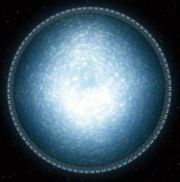
An Ori Supergate
Ori Supergates[]
- Main article: Supergate
A Supergate is a massive Stargate developed by the Ori, spanning three to four hundred meters across. All known Supergates have been used for the specific purpose of establishing permanent footholds in distant locations in the universe, permitting the rapid passage of the Ori Army's enormous motherships across intergalactic distances.
Orlin's homemade Stargate[]
- Main article: Mini Stargate
The outcast Ancient, Orlin built a miniature Stargate in Samantha Carter's basement. Its components included 100 pounds of pure raw titanium, 200 feet of fiber optic cable, seven 100,000 watt industrial strength capacitors, and a toaster. This gate was hooked up to the main power supply of the house and only connected once, to Velona, before it burnt out. [citation needed]
Tollan Stargate[]
- Main article: Tollan Stargate

Tollan Stargate
The Tollan were an advanced human civilization. Among their most impressive technological accomplishments was the construction of a new Stargate, built mainly with knowledge provided by the Nox.
With the destruction of the original Tollan homeworld, the Tollan's Stargate was lost. Their new homeworld, Tollana, had no original Stargate, and with the assistance of the Nox, a new gate was built.
The Tollan gate was smaller and slimmer than the Ancient's Stargates, and has a pale white color. However, it seemed to lack a DHD, or even an inner track for manual dialing, suggesting the control of it was inside a nearby building using remote dialing. [citation needed] Eventually the Tollan Stargate was hit by a Goa'uld Ha'tak's weapons and was presumably destroyed by the attack, as reported by Narim to the SGC. [citation needed]
McKay-Carter Intergalactic Gate Bridge[]
- Main article: McKay-Carter Intergalactic Gate Bridge
The middle of the Gate Bridge
The McKay-Carter Intergalactic Gate Bridge was a project to place a chain of Stargates in the void between the Milky Way and Pegasus galaxies; it was initiated to allow rapid transit between Atlantis and the SGC without the need of a ZPM to power the Stargate. [citation needed] At the time, only the Atlantis gate had a ZPM available, meaning that the return trip from Earth required a eighteen-day journey in a hyperspace-capable Daedalus-class battlecruiser. To this end, Stargates were "harvested" from the surface or orbit of uninhabited planets and deposited accordingly on both ends. When Atlantis' ZPM was depleted,[citation needed] the project took on an added urgency and was made operational shortly afterward.
The bridge (named as such by its co-creator Rodney McKay, recognizing Samantha Carter for the original idea) consists of seventeen Stargates from the Pegasus network and another seventeen from the Milky Way network. A macro program written by McKay and uploaded to the gates' operating systems before dialing causes them to store incoming matter in their buffers, forwarding travelers from one gate to the next along the bridge, rather than emerging from the gate that is initially dialed.
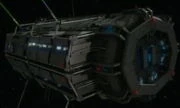
The Midway space station
Travelers will then exit at the Midway space station, halfway between galaxies, which serves as a transfer point. There, they will then use the other gate network (and a second macro program designed for that network) to continue on to their ultimate destination: travelers from Atlantis would use a Milky Way gate to travel on to Earth and similarly, travelers from Earth would use a Pegasus gate to travel to Atlantis. Even with this, the travel time between galaxies is just slightly over thirty minutes, making it far more efficient than traveling by hyperdrive.
When the first test of the gate bridge was conducted, only the framework of the station had been completed, so a gateship was used. The test was a complete success, and the bridge was declared operational. It was later revealed that, since the last gate in the bridge must dial the exit gate, normally either Atlantis or Earth, the macro can be rewritten to dial a different exit gate in the destination galaxy. [citation needed] The Midway station has since then been destroyed by the Wraith.
Asuran Stargate Satellite[]

The Asuran Stargate Satellite
- Main article: Asuran Stargate Satellite
The Asurans had developed an eight-chevron variant of a Stargate that was created as a satellite weapon. Its components included a shield generator, sensors and a hyperdrive, allowing it to orbit its intended target. Once this was accomplished, a wormhole was to be activated, after which an intense red energy beam reaches out and strikes the target which, in this case, was the city of Atlantis. The beam would originate from an Asuran stronghold which would both power the satellite's defenses as well as maintain an ongoing wormhole.
The satellite also had the added effect of preventing Stargate travel through the Atlantis Stargate as long as the satellite maintained its connection to the dialing Stargate, as both gates would be attempting to use the Atlantis coordinates. The satellite was able to receive the incoming wormhole from the Asurans, indicating that it could override the Atlantis Stargate, the dominant Stargate on the planet due to its being connected to a DHD. It appeared as a satellite with a Stargate in the center of its form which allowed it to maneuver and, thus, direct the energy weapon. [citation needed]
Glyphs[]
- Main article: Glyph
Glyphs are symbols on Stargates which chevrons lock onto when a Stargate is being dialed. The basis for glyphs are star constellations. There are several differences between the Milky Way, Pegasus Galaxy, and Destiny glyphs.
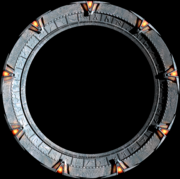
An inactive Milky Way Stargate.
Behind the scenes[]
- The Gateway Command from the series ReBoot is based off of the design of the Stargate.
- The entirety of the Stargate Universe (Destiny) gate design does not actually spin. Only the front plate does. [3]
See also[]
- Asuran Stargate Satellite
- Dial Home Device
- Supergate
- Spacegate
- Stargate Destroyer
- Tollan Stargate
- Mini Stargate
- Stargate Network
References[]
External links[]
- Template:Lexicon
- Template:GWomni
- Template:Solutionswiki
- Template:WP
| This page uses Creative Commons Licensed content from Wikipedia (view authors). | 
|
Template:Featured article